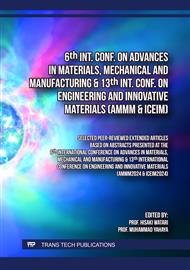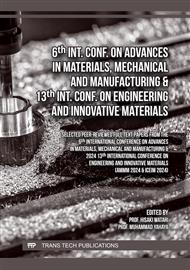[1]
N. A. Alang, L. Zhao, K. Nikbin, Evaluation of Monkman-Grant strain as a key parameter in ductility exhaustion damage model to predict creep rupture of Grade 92 steel, J. Strain Anal. Eng. Des. 57 (2022) 392-408.
Google Scholar
[2]
S. Arunkumar, Small punch creep test: An overview, Met. Mater. Int. 27 (2021) 1897–1914.
DOI: 10.1007/s12540-020-00783-w
Google Scholar
[3]
British Standards Institution, Metallic materials - Small punch test method, EN 10371:2 (2021).
Google Scholar
[4]
J. Chakrabarty, A theory of stretch forming over hemispherical punch heads, Int. J. Mech. Sci. 12 (1970) 315–325.
DOI: 10.1016/0020-7403(70)90085-8
Google Scholar
[5]
S. P. Jeffs, R. J. Lancaster, T. E. Garcia, Creep lifing methodologies applied to a single crystal superalloy by use of small scale test techniques, Mater. Sci. Eng. A, 636 (2015) 529–535.
DOI: 10.1016/j.msea.2015.03.119
Google Scholar
[6]
D. Blagoeva, Y. Z. Li, R. C. Hurst, Qualification of P91 welds through Small Punch creep testing, J. Nucl. Mater. 409 (2011) 124–130.
DOI: 10.1016/j.jnucmat.2010.09.015
Google Scholar
[7]
F. Monkman, N. Grant, An empirical relationship between rupture life and minimum creep rate in creep-rupture tests, Proc. ASTM. 56 (1956) 593–620.
Google Scholar
[8]
B. Ule et al., Small punch test method assessment for the determination of the residual creep life of service exposed components: outcomes from an interlaboratory exercise, Nucl. Eng. Des. 192 (1999) 1–11.
DOI: 10.1016/s0029-5493(99)00039-4
Google Scholar
[9]
R. J. Lancaster, W. J. Harrison, G. Norton, An analysis of small punch creep behaviour in the γ titanium aluminide Ti-45Al-2Mn-2Nb, Mater. Sci. Eng. A. 626 (2015) 263–274.
DOI: 10.1016/j.msea.2014.12.045
Google Scholar
[10]
M. Abendroth, "FEM analysis of small punch tests, Key Eng. Mater. 734 (2017) 23–36.
DOI: 10.4028/www.scientific.net/kem.734.23
Google Scholar
[11]
I. U. Ferdous, N. A. Alang, J. Alias, A. H. Ahmad, S. Mohd Nadzir, Rupture life and failure mechanism of Grade 91 steel under the influence of notch constraint, J. Fail. Anal. Prev. 23 (2023) 497–510.
DOI: 10.1007/s11668-022-01575-7
Google Scholar
[12]
I. U. Ferdous, N. A. Alang, J. Alias, S. M. Nadzir, Numerical prediction of creep rupture life of ex-eervice and as-received Grade 91 steel at 873 K, Int. J. Automot. Mech. Eng. 18 (2021) 8845–8858.
DOI: 10.15282/ijame.18.3.2021.01.0678
Google Scholar
[13]
S. Arunkumar, Overview of small punch test, Met. and Mater. Inter. 26 (2020) 719–738.
DOI: 10.1007/s12540-019-00454-5
Google Scholar
[14]
K. Kimura, H. Kushima, K. Sawada, Long-term creep deformation property of modified 9Cr–1Mo steel, Mater. Sci. Eng. A. 510–511 (2009) 58–63.
DOI: 10.1016/j.msea.2008.04.095
Google Scholar
[15]
L. Zhao et al., Determination of creep properties of an advanced Fe-Cr-Ni alloy using small punch creep test with a modified creep strain model, Theor. Appl. Fract. Mech. 104 (2019) 102324.
DOI: 10.1016/j.tafmec.2019.102324
Google Scholar
[16]
Y. Zhang, H. Jing, L. Xu, L. Zhao, Y. Han, J. Liang, Microstructure and texture study on an advanced heat-resistant alloy during creep, Mater. Charact. 130 (2017) 56–172.
DOI: 10.1016/j.matchar.2017.05.037
Google Scholar
[17]
P. Dymáček, M. Jarý, F. Dobeš, L. Kloc, Tensile and creep testing of Sanicro 25 using miniature specimens, Mater. 11 (2018) 142.
DOI: 10.3390/ma11010142
Google Scholar



